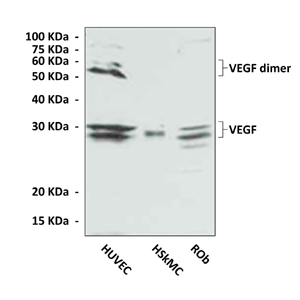Product Sheet CA1080
Description
BACKGROUND Vascular endothelial growth factor (VEGF, also designated as VEGF-A) is the founding member of a family of homodimeric glycoproteins that are structurally related to the platelet-derived growth factors (PDGF); this family also includes placenta growth factor (PlGF), VEGF-B, VEGF-C, VEGF-D and VEGF-E. This VEGF family of proteins binds selectively with different affinities to at least five distinct receptors. Three of them belong to the superfamily of receptor tyrosine kinases and are termed VEGF receptor-1 (VEGFR-1), also called Flt-1 (fms-like tyrosine kinase 1), VEGFR-2, also called KDR (kinase insert-domain containing receptor) in humans, and Flk-1 (fetal liver kinase 1) in rodents, respectively, as well as VEGFR-3, also called Flt-4. The fourth and fifth receptors are neuropilin-1 and neuropilin-2.1
VEGF is a highly specific mitogen for vascular endothelial cells. Five VEGF isoforms of 121, 145, 165, 189 and 206 amino acids (VEGF121-206) are generated as a result of alternative splicing from a single VEGF gene. These isoforms differ in their molecular mass and in biological properties such as their ability to bind to cell-surface heparan-sulfate proteoglycans. The expression of VEGF is potentiated in response to hypoxia, by activated oncogenes, and by a variety of cytokines. VEGF induces endothelial cell proliferation, promotes cell migration, and inhibits apoptosis. In vivo VEGF induces angiogenesis as well as permeabilization of blood vessels, and plays a central role in the regulation of vasculogenesis.2 Deregulated VEGF expression contributes to the development of solid tumors by promoting tumor angiogenesis and to the etiology of several additional diseases that are characterized by abnormal angiogenesis. Consequently, inhibition of VEGF signaling abrogates the development of a wide variety of tumors.3
REFERENCES
1. Kurebayashi J et al.: Jpn J Cancer Res. 90:977-81, 1999.
2. Shinkaruk S et al.: Curr Med Chem Anticancer Agents. 3:95-117, 2003.
3. Rini BI: Oncologist 10:191-197,2005.
2. Shinkaruk S et al.: Curr Med Chem Anticancer Agents. 3:95-117, 2003.
3. Rini BI: Oncologist 10:191-197,2005.
Products are for research use only. They are not intended for human, animal, or diagnostic applications.
Details
Cat.No.: | CA1080 |
Antigen: | Human VEGF sequence (106-130aa) |
Isotype: | Rabbit Polyclonal |
Species & predicted species cross- reactivity ( ): | Human, Rat, Mouse |
Applications & Suggested starting dilutions: | WB 1:1000 IP 1:50 IHC (Paraffin) 1:100 ICC n/d FACS n/d |
Predicted Molecular Weight of protein: | 23 kDa |
Specificity/Sensitivity: | Detects endogenous levels of VEGF protein in normal primary cell lysates. |
Storage: | Store at 4° C for frequent use; at -20° C for at least one year. |
*Optimal working dilutions must be determined by end user.
Products
| Product | Size | CAT.# | Price | Quantity |
|---|---|---|---|---|
| Polyclonal Vascular Endothelial Growth Factor Antibody: Polyclonal Vascular Endothelial Growth Factor Antibody | Size: 100 ul | CAT.#: CA1080 | Price: $375.00 |

